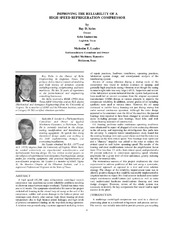| dc.description.abstract | A high speed (15,200 rpm) refrigeration centrifugal recycle compressor was experiencing severe reliability problems resulting in short run times between major overhauls. Typical run times were one to 12 weeks. The symptoms identified at the start of the project included oil foaming in the closed loop oil sump on the end of the compressor, sudden and severe damage to the balance piston and interstage seals shortly after startup, high thrust bearing oil drain temperature (due to high balance piston leakage), and high levels of process contaminant fouling on the impellers during operation. A solution was pursued using a systems approach including review of repair practices, hardware installation, operating practices, lubrication system design, and rotordynamic analysis of the rotorbearing system. Review of casing vibration during a startup cycle of the compressor was found to include evidence of surging, and generally high amplitude casing vibration even though the casing to rotor weight ration was very large (~40:1). Inspection and review of the lubrication system indicated that the system had previously been modified on several occasions from the original equipment manufacturer (OEM) design in various attempt to improve the compressor reliability. In addition, several grades of oil including synthetic were used at various times. However, the oil sump continued to exhibit heavy foaming not just during startup but under normal continuous operation. Although the rotor design appeared to be consistent over the life of the machine, the journal bearings were reported to have been changed to several different styles, including pressure dam bearings, fixed lobe, and with various bearing materials of construction. Oil foaming problems under continuous operating conditions were eliminated by repair of clogged oil mist coalescing elements in the oil sump, and improving the oil/refrigerant flow paths into the oil sump. A complete lateral rotordynamics study found that the existing bearings were not a good choice and that the rotor was operating on the first critical speed. New bearings were optimized and a “dummy” impeller was added to the rotor to reduce the critical speed to well below operating speed. The results of the bearing and rotor modifications reduced the amplification factor from 19 to less than 2.5 at the first critical speed, and predicted a 90 percent reduction in center-span operating speed vibration amplitudes for a given level of rotor unbalance, greatly reducing the risk for internal rubs. The tremendous success of this project emphasizes the clear requirement to address problems of this sort using a systematic, engineered approach as opposed to a trial and error solution strategy. The charge of the reliability improvement team was to identify positive changes that could be reasonably implemented to lengthen run time to repair. The final solution included some rather simple maintenance modifications (oil system) as well as some very sophisticated hardware modifications (bearing and rotor design changes). However, review of the whole system was necessary to identify the key components that would lead to rapid success in the plant. | en |


